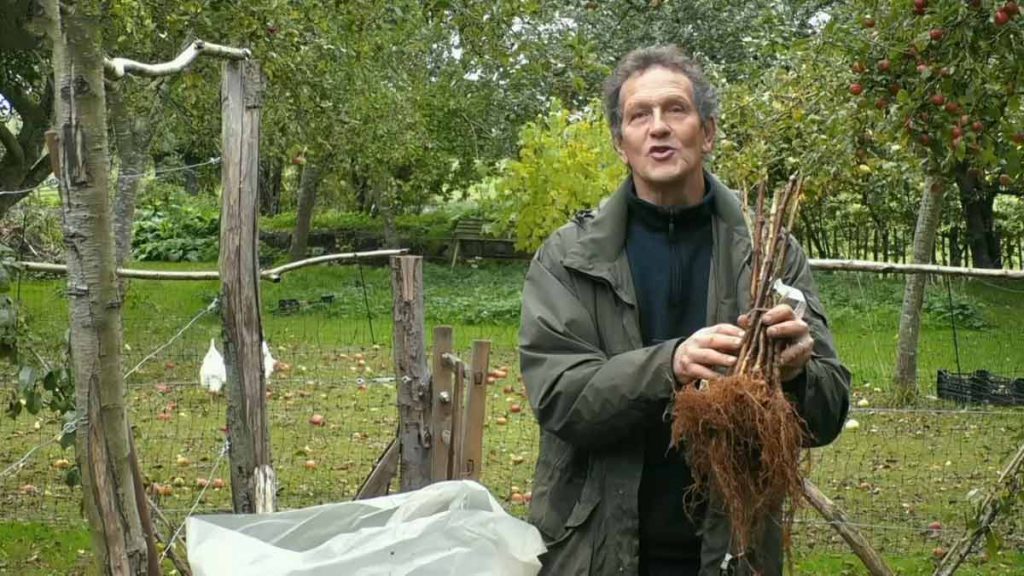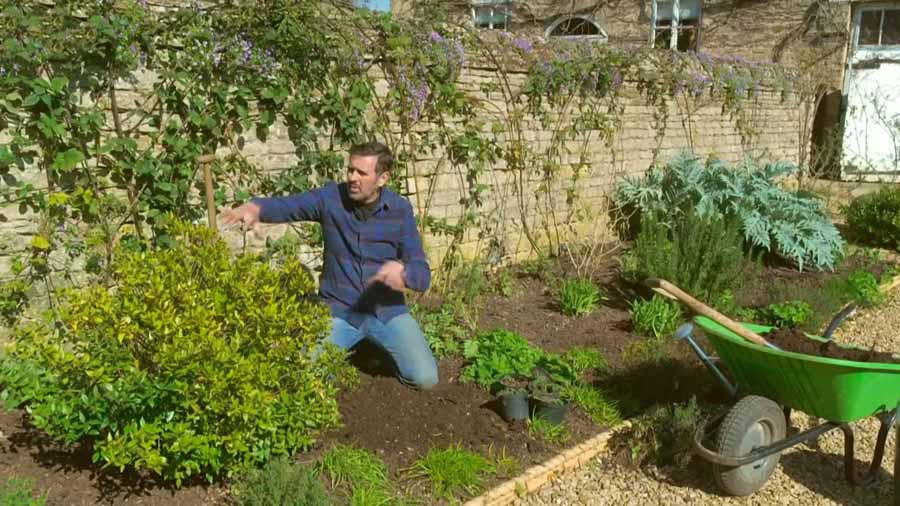Gardeners World episode 32 2020: At Longmeadow, Monty shares his tips on how to feed the birds over the coming months, plants raspberries both in the ground and in a pot, and makes a start on lifting his tender salvias.
Joe Swift visits a nurseryman in Essex who loves to experiment with ornamental grasses, and Arit Anderson meets Fergus Garrett, head gardener at Great Dixter, to discover how the planting and garden management have increased biodiversity.
We meet a couple in Staffordshire with a particular fondness for Japanese maples and a man whose love of dahlias has taken over his back garden in Stockport. Plus what viewers have been doing in their own gardens.
Gardeners World episode 32 2020
How to take hardwood cuttings
Hardwood cuttings provide an easy and reliable method of propagating a range of deciduous climbers, trees and shrubs, and as bonus, they are taken from mid-autumn until late winter when more time is usually available to the gardener. Some evergreen plants, hollies for example, can also be taken at the same time of year as other hardwood cuttings.
Most deciduous shrubs including: Abelia, Deutzia, Buddleja (butterfly bush), Cornus (dogwood), Forsythia, Philadelphus (mock orange) Ribes (flowering currant), Rosa (rose), and Symphoricarpos and viburnums.
Many climbers can be propagated by hardwood cuttings: Vitis (vines), Lonicera (honeysuckle), Jasminum, and Parthenocissus.
Fruit, including: gooseberries, black, red and white currants, fig, mulberry.
Trees, including: Platanus (plane), Populus (poplars) and Salix (willow).
Although usually restricted to deciduous plants, some evergreen cuttings can be taken at the same time as hardwood cuttings including Cotoneaster, Ilex (holly), Ligustrum (privet) and Skimmia. The best technique for taking evergreen cuttings at this time of year is that used for semi-ripe cuttings.
How to grow agapanthus
These dramatic sun-loving border plants produce large spherical flowerheads, usually in beautiful shades of blue, from midsummer onwards. These sway on tall stems above clumps of strappy foliage. Some types, especially the evergreens, may not be fully hardy, so are best grown in containers that can be protected from frost over winter.
Water regularly in the growing season, especially in the first year after planting. Once established they will need little watering, but some in late summer in very dry years will help ensure good flowering in the next year.
Feed border plants in spring when they start to come into growth with a balanced fertiliser, such as Vitax Q4, Growmore or fish, blood and bone at the manufacturers recommended dose.

For containers, use a liquid fertiliser, such as Phostrogen or seaweed feed, diluting according to the instructions on the bottle. Feed fortnightly from April until flowers begin to show colour.
Ornamental grasses in Gardeners World episode 32 2020
Ornamental grasses can be used to great effect in our gardens, from providing a calming presence to more exuberant flowering plants to being the only focus of the design. There are grasses for damp or dry soil, shady as well as sunny situations. Many are ideal for gravel gardens, prairie planting, wildlife gardens and are great to add to the cutting garden; others perform well in containers.
Ornamental grasses tolerate a wide range of conditions, but most like an open sunny position in light, moist but well-drained, moderately fertile soil.
They do not need much feeding; this can encourage lush foliage at the expense of flowers. One application of a balanced fertiliser in spring is adequate.
Grasses are good plants for containers. Use loam-based compost such as John Innes No 2 with 20 percent loam-free compost to lighten the mix. Evergreen grasses such as Carex combine well with winter bedding to give height and a contrast in texture.
Grow your own raspberries
Raspberries are one of the most popular summer fruits and are very easy to grow. Different training techniques mean raspberries can be grown in gardens of any size and in containers.
Raspberries thrive in moisture-retentive, fertile, slightly acidic soils pH 6.5-6.7, which are well-drained and weed-free. They dislike waterlogged soils and shallow chalky soils. For best results, plant in a sheltered, sunny position. They will tolerate light shade, but the yield is likely to be reduced.
In early March, apply Growmore or naturally slow-release general fertiliser, fish, blood and bone for example, at 30g per sq m (1oz per sq yd), then mulch with well-rotted organic matter. If the growth is weak, apply sulphate of ammonia at 30g per sq m (1oz per sq yd) or dried poultry manure pellets at 90g per sq m (3oz per sq yd).
Keep raspberries well-watered during dry periods, but avoid overwatering. Avoiding drought stress is especially important during fruit set and development. Apply water preferably at ground level; drip irrigation systems or a leaky hose is ideal. Keeping the foliage, flowers and developing fruit dry helps to reduce the risk of fungal diseases.
Japanese maples in Gardeners World episode 32 2020
The attractive delicate foliage of Japanese maples (Acer palmatum) is prone to leaf scorch. Cultivars with heavily dissected foliage are particularly prone. Scorch occurs following environmental stresses, such as drying winds, and leads to the foliage turning brown.
Leaf scorch rarely causes long-term damage, but it can leave an affected tree unsightly for the remainder of the growing season. Scorch happens whenever water is lost from the leaves more quickly than the roots can take it up. A wide range of environmental factors can cause this such as frost, drought including under-watering, waterlogging, drying winds, hot sun and even salt-laden winds in coastal areas.
Overwintering tender plants
Tender plants can be cut back, lifted and stored in a dormant state, or protected with a covering of organic matter (known as mulch). The decision on whether to lift and store or leave them outside under mulch depends both upon the plant and the local climate.
Tender herbaceous perennials that can be lifted and stored include dahlias, cannas, tuberous begonias and gladioli. All these plants have fleshy tubers, rhizomes (underground stems) or corms that can survive in a dormant state when lifted and stored.
In milder areas of the UK and in sheltered, well-drained, parts of the garden, it may be possible to cut back the tops of tender plants, leave them in the ground and cover them with a thick mulch to protect them over winter. In very cold or exposed areas, even hardy perennials may need the protection of mulch over winter.
Grow your own cut flowers
Many garden plants can be enjoyed as cut flowers and foliage in the home, offering cheaper and diverse alternatives to florist flowers. Borders can be adapted to provide cutting material throughout the year. Alternatively, dedicate a part of the garden to growing cut flowers.
When adapting existing borders, plant larger groups of annuals, perennials and bulbs suited for cutting to allow for picking without affecting the overall appearance of the border. Do not forget to incorporate a few well-chosen shrubs and grasses with interesting foliage. Use bulbs to extend the picking season.
If space allows, dedicate a part of the garden to growing just cut flowers. The advantage of a cutting garden over picking from borders is that it avoids depleting beds and borders, as well as providing a more productive planned area for the cut flower gardener.
Plant or sow in rows; this makes weeding, staking and picking so much easier. Take the final spread of plants into account and allow access between the rows. If planted too close together, plants will fall into each other, get tangled and may be damaged, making them less suitable for harvesting. As taller plants are often grown for cut flowers, robust supports are usually needed.





Pingback: Gardeners World episode 33 2020 — HDclump — Gardeners’ World 2020